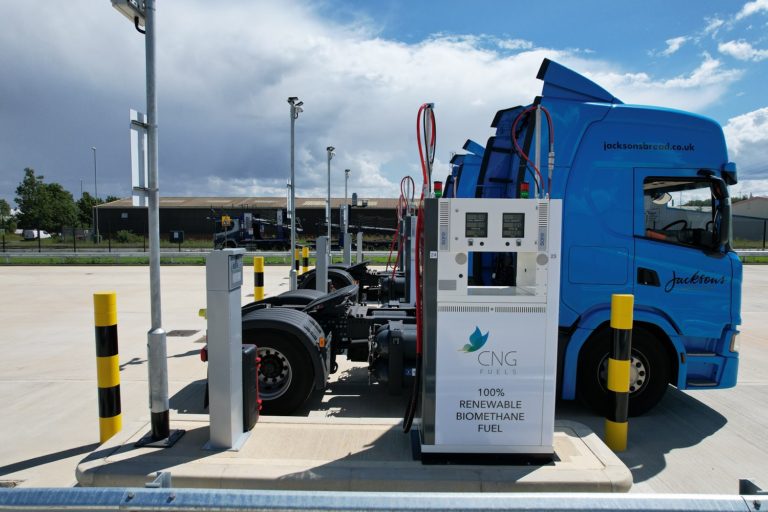
CEO Philip Fjeld claims Bio-CNG is “becoming the clean fuel of choice” for UK fleet operators but is this really the case?
Cost and return on investment
Philip highlights lower operational costs as a key reason for Bio-CNG’s increasing popularity: “Bio-CNG is becoming the clean fuel of choice for UK feet operators with lower costs than traditional diesel and HVO.”
He also points to strong adoption in the 4×2 truck market, in which ReFuels serves 2000 plus trucks running on Bio-CNG – 10% of the UK total – and growing interest in the newly available 6×2 CNG trucks, which he says, “opens a market six times larger”.
Latest market statistics from Zemo Partnership confirm that the greatest uptake of biomethane has been in the 44t arctic HGV sector, where high mileage rates see an attractive financial return due to lower cost of the fuel compared to diesel.
Zemo statistics also indicate a steady increase in HVO adoption in HGVs, with numbers rising to 5000 this year.
Infrastructure challenges
While total cost of ownership over five years may be lower, the initial capital outlay for Bio-CNG – compatible vehicles and infrastructure remains a major consideration for operators.
Bio-CNG infrastructure also lags behind as Philip acknowledges: “Even for those fleets used to on-site diesel bunkering, CNG bunkering is expensive to build and requires a grid gas network – this is a big hurdle initially.
“Acceleration of uptake needs a nationwide network of truck-friendly access stations.”
Currently, there are just 16 public-access, truck-friendly sites operational, all built with private equity. “More stations mean more trucks, but the challenge to building infrastructure is monumental,” Philip comments, explaining how site selection, planning and construction can take up to two years “if you’re lucky” – or more, as one still unbuilt site shows after eight years in development.
Philip stresses that planning system is urgently needed to unlock growth. Yet, despite these bottlenecks, he remains optimistic with increasing investment and cooperation and ongoing site development and launches, such as the recent Livingstone facility sited near a Tesco fleet depot.
Vehicle availability and fleet planning
For larger operators like Tesco and DHL – typical ReFuels customers – long-term fleet replacement cycles (15 to 20% annually) support strategic shifts to Bio-CNG
“We’re not talking about tomorrow,” Philip explains. “Planning for the longer term will enable them to select Bio-CNG-ready vehicles as part of their fleet replacement programme.”
Philip also notes the recent availability of 6×2 CNG truck models which has removed another barrier to adoption.
Sustainability and supply chain confidence
Philip has no supply concerns insisting: “Biomethane supply is chasing transport demand and is not constrained by feedstock availability.”
Refuels has worked with Foresight Group, to align biomethane sourcing, refuelling infrastructure and certificate generation in one fully-equity funded platform, and says it is positioned to “double capacity over the next three years”.
“We have already secured supply for the whole of 2025, are working on 2026 with no anticipated supply issues.”
With HVO feedstocks increasingly required for SAF production, Philip sees a growing advantage in locally sourced biomethane giving confidence in both supply and sustainability. “Biomethane is a locally sourced feedstock – sewage does not get imported or exported.”
Speaking on behalf of the Zemo Partnership, Gloria Esposito, Zemo’s fuels team lead, also highlighted that ensuring the sustainability of the fuels through their production pathways and integrity of the waste-based feedstocks is vital noting that “All biomethane and HVO supplied to UK truck operators is sourced from 100% biomass waste feedstocks, evidenced by Zemo’s Renewable Fuels Assurance Scheme (RFAS).”
RFAS provides independent assurance of renewable fuel supply chain traceability, providing confidence to fleet operators with regard to the source of biogenic feedstocks and GHG emission performance.
HVO – the practical choice today
Despite Bio-CNG’s growing appeal, HVO remains the short-term favourite with many operators, and Philip acknowledges that several ReFuels customers are running both HVO and Bio-CNG trucks in their fleets.
“HVO is a here and now and is an amazing fuel,” Philip acknowledges. “As a ‘drop-in’ diesel alternative, HVO allows immediate emissions cuts with no requirement for new infrastructure or vehicles. It is the obvious solution for smaller fleet operators whose fuel choices are being driven by the immediate pressures of tender requirements.
Richard Garnett, Head of Sustainability for Certas Energy, agrees: “Currently, HVO from Certas Energy provides an immediate decarbonisation solution for liquid fuels without costly vehicle modifications.”
A multi-fuel future
It is clear that fleet decarbonisation won’t be solved by a single fuel. With longer term planning, other fuels can be considered, and the operational cost and emission reduction of Bio-CNG comes into play.
“As part of DCC plc, Certas Energy UK and Flogas Britain support a multi-energy strategy,” Richard confirms, before adding: “As the transport industry decarbonises, new renewable fuels will emerge, each complementing the energy mix.”
And Gloria agrees: “There is certainly a role for both bio-CNG and HVO, particularly in the HGV sector where, for many applications, there are currently no practical zero emission options.”
Prema Energy adds that Bio-CNG’s promise is tempered by the “significant hurdles” of “considerable capital expenditure” that can outweigh fuel savings, as well as a lack of “widespread infrastructure readiness” making HVO “a more immediate and practical solution.”
“Ultimately, we believe that fleet decarbonisation isn’t an ‘either/or’ scenario. Different sustainable fuels will likely sit alongside each other, each playing a role depending on fleet specificities, operational demands, and infrastructure development over time.”
With 145,000 trucks to decarbonise, Philip agrees: “In a free market, people find solutions.”
Image credit: ReFuels NV

